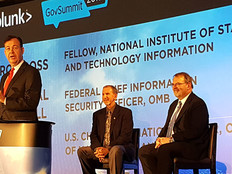What Is the Government’s Role in Growing IoT?
The Commerce Department recently released a “green paper” on the Internet of Things, designed to share the department’s view on how to best promote and advance IoT adoption.
The paper, “Fostering the Advancement of the Internet of Things,” is an analysis of comments offered during a previous request for comment focused on IoT.
Commerce identifies areas of engagement for IoT, and the agency outlines where it could help the advancement of Iot in the country. One area of particular interest was infrastructure availability and access.
The Need for More Network Bandwidth and Access
Cisco Systems recently forecast that monthly global mobile data traffic will increase to 49 exabytes per month by 2021 — up from 7 exabytes in 2016 (1 exabyte equals 1 billion gigabytes). Part of that growth will be attributable to the adoption of IoT devices, spurring demand for greater overall network capacity and smarter use of bandwidth in the very near future.
With many IoT devices utilizing wireless technologies, demand on the wireless spectrum will also increase. While there are many promising approaches to addressing this demand (such as Long Range Wide Area Network, or LoRaWAN), the federal government will need to provide guidance on how to squeeze greater efficiencies out of the available airwaves.
IoT will also dramatically increase the demand for IP addresses, which underlines the importance of continuing to encourage more users to transition from IPv4 to the IPv6 addressing scheme. The activation of more IoT devices will only hasten the depletion of the 4.3 billion possible IPv4 addresses. The department believes that IPv6’s potential 340 trillion trillion trillion addresses offers a way out of this increasing address shortage.
Many commentators in the Commerce Department report also touched on the need for equitable deployment of IoT, so that underserved communities are not left out of the benefits of IoT deployments. With so much potential gain from IoT in the areas of health, economic and personal welfare, the government and private sector will need to work together to ensure that everyone benefits from this technology, the report states.
Setting up IoT for Success
The department’s list of planned activities to address these looming issues includes empowering local communities to become smart cities. Assistance with this process is available through the National Telecommunications and Information Administration’s “Using Partnerships to Power a Smart City: A Toolkit for Local Communities,” a guide for helping communities embed digital technologies into municipal infrastructure through successful public-private partnerships.
NTIA is also leading research and development into spectrum-related interactions through its Institute for Telecommunications Sciences. The goal of this IoT test bed is to better understand the performance and behavior of IoT systems so that a neutral body of knowledge and expertise can be made available for future policymaking.
Finally, public safety is an area that has much to gain from IoT. Toward that end, Commerce has taken steps to enable IoT functionality for first responders through the First Responder Network Authority’s Nationwide Public Safety Broadband Network. Congress allocated $7 billion and 20 megahertz of spectrum for NPSBN in 2012.
This LTE-based wireless broadband network, when operational, will enable first responders to send and receive text, voice, video, images, location information and other data in real time to increase situational awareness and operational capability in the field.








